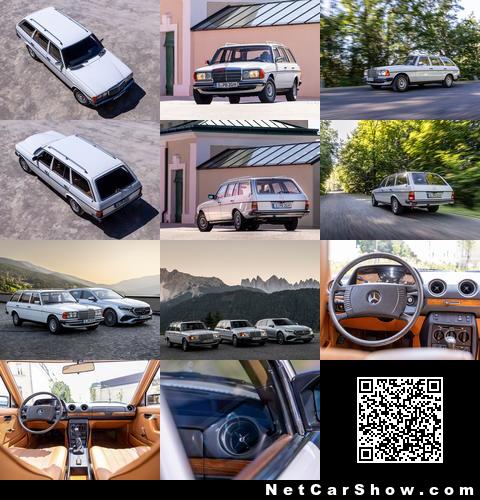Mercedes-Benz 280 TE
As diverse and versatile as never before: the upper medium-size category car from Mercedes-Benz from 1976 onwards gave people good reason to dream thanks to its state-of-the-art body design and exemplary equipment level. In total, Mercedes-Benz built around 2.7 million of the 123 model series up to the beginning of 1986 - more than any other generation in the history of the E-Class. The demand for the model series was so great that the cars in the first production year were sold out soon after the launch - some customers had to wait up to a year for their cars. Model series 123 was so popular right from the outset that its resale price stayed high for the duration of its biography. In September 1976, the "mot auto-journal" published its prediction regarding the 200 D: "No comparable car can boast such low depreciation."
Diversity was a key characteristic of this generation. Model series 123 was the first to produce an estate (1977) and, once again, there was a sporty but elegant coupé and the seven or eight-seater long-wheelbase limousine. When the limousine was launched in January 1976, Mercedes-Benz also offered a choice of nine different engines with outputs ranging from 40 kW (55 hp) to 130 kW (177 hp). The range of petrol engines covered the 200, 230, 250, 280 and 280 E models and the diesels were the 200 D, 220 D, 240 D and 300 D. One particular detail of the trial driving launch in the south of France emphasised the tremendous choice of variants available when this model series was launched on the market: in order to transport all 33 test vehicles with their different engines and trim lines to the Côte d'Azur, the company chartered an entire special train from what was then German Federal Railways.
The concept cars made for the saloons also included futuristic visions with angular lines, massive rear roof overhangs, steeply raked rear windows and bulky rubber panels around the body. However, the most audacious of these designs remained safely in the drawer and, by 1973, the classically elegant lines of the model series had largely been defined. It also characterised the coupés (40 millimetres lower, 85 millimetres shorter, with a stretched, dynamic silhouette) and the estates (the first E-Class estate produced in-house).
The estate came out in September 1977 and set standards for estates as family-orientated lifestyle and leisure cars, especially with the automatic hydropneumatic level control system as standard equipment. Called the "T-Modell" in German, the T stood for "tourism and transport" and emphasised the dual role of this versatile vehicle from the upper medium-size category. With its estate car, Mercedes-Benz launched - for the first time in Germany - a passenger car with a diesel engine and exhaust-gas turbocharger in 1980, the 92 kW (125 hp) 300 TD Turbodiesel. For export to North America and Japan, this engine configuration was also available as a saloon. The American magazine "Road & Track" wrote this about the estate in April 1981: "Undoubtedly the Mercedes 300 TD is the finest station wagon offered in the U.S. today and it is certainly the classiest."
Not only the design but also the technology inherent in the 123 model series were state-of-the-art. These cars had double-wishbone front suspension with a zero scrub radius, and they had a safety steering column incorporating a corrugated tube in line with Béla Barényi's design. A further passive safety feature was the collision-protected fuel tank located above the rear axle. In the 123 model series, Mercedes-Benz offered cruise control as an optional extra plus, from 1980 on, the anti-lock ABS braking system and, from 1982, the driver airbag - available for the first time in this vehicle category. Power-assisted steering became standard equipment from 1982. Tests with alternative drive systems in model series 123 vehicles such as hydrogen, electric motors and liquefied petroleum gas (LPG) were a clear reference to future developments. This generation took the success story of the brand's upper medium-size category models to new sales records: around 2.7 million cars were built, almost 2.4 million of them saloons, around 200,000 estates and nearly 100,000 coupés.
It was the London-Sydney marathon in 1977 that allowed the 123 model series to demonstrate very clearly its sporting endurance and performance as well as its comfort and reliability: two Mercedes-Benz 280 E cars won what was at the time the world's toughest rally, and two other saloons of the same model also finished in the top ten. The brand with the star mainly used standard-trim saloons for this spectacular endurance race. The 280 Es were only fitted with different wheels, had a few chassis modifications and sturdy dust shields instead of the standard bumpers.






![2025 Audi S5 Sedan [US]](/R/Audi-S5_Sedan_US-Version-2025-thb.jpg)
![2025 Audi A5 Sedan [US]](/R/Audi-A5_Sedan_US-Version-2025-thb.jpg)
![2025 Kia EV6 GT [UK]](/R/Kia-EV6_GT_UK-Version-2025-thb.jpg)



![Mercedes-Benz SL43 AMG [UK] (2023)](/R/Mercedes-Benz-SL43_AMG_UK-Version-2023-ec-79fb27c416e9e9a6d3a03d4a6044c08d43.jpg)

![Mercedes-Benz CLS63 AMG [US] (2012)](/R/Mercedes-Benz-CLS63_AMG_US_Version-2012-ec-765585ba481bf6aa3d14a99c50d5871e90.jpg)

![Mercedes-Benz EQE [UK] (2023)](/R/Mercedes-Benz-EQE_UK-Version-2023-ec-86570eb61b9813183307ad99e01c6bdbd1.jpg)












